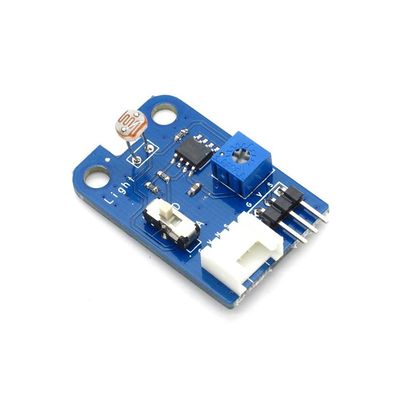Light Sensor Brick
Contents
Overview
Electronic brick of light sensor is mainly used to detect the light intensity in the environment. The control board can get the current light intensity information via analog pins. Generally speaking, the resistance of photoresistor decreases with the increase of the light intensity.
Features
1. Plug and play, easy to use. Compatible with the mainstream 2.54 interfaces and 4-Pin Grove interfaces in the market.

2. With use of M4 standard fixed holes, compatible with M4-standard kits such as Lego and Makeblock.

3. With switch to shift between analog and digital output. Able to read the specific light intensity information (analog) or the over-bright or over-dark information according to the threshold (digital). The adjustable potentiometer is used to set the light intensity threshold. With hysteresis comparator circuit for more stable digital output voltage.

4. Detecting direction can be rotated for better adaption

Specifications
| PCB size | 36.0mm X 24.0mm X 1.6mm |
| Working voltage | 3.3 or 5V DC |
| Operating voltage | 3.3 or 5V DC |
| Compatible interfaces | 2.54 3-pin interface and 4-pin Grove interface(1) |
Note 1: D for digital output port, A for analog output port, S for analog/digital output port ( defined according to the switch), V and G for voltage at the common collector and ground respectively
Note 2: When setting as analog output, output range is 0-3.3V or 0-5V according to the working voltage (V,G); when setting as digital output, output is 0/3.3V or 0/5V according to the working voltage (V,G).
Electrical Characteristics
| Parameter | Min. | Typical | Max. | Unit |
| Working voltage | 2.1 | 5 | 5.5 | VDC |
| Analog output voltage(VCC=5V) | 0 | Vout | 5 | V |
| Digital output voltage(VCC=5V) | 0 | - | 5 | V |
| Working current(VCC=5V) | - | 5 | - | mA |
| Photoresistor(light intensity is 10lux) | 5 | - | 10 | kohm |
| Threshold hysteresis ΔUth | - | VCC*0.09 | - | V |

Hardware

Switch and indicator
1. Regulating of threshold voltage:
The threshold voltage is a voltage for comparison. When the light intensity value read by the sensor is above the threshold value, a low level (0V) will be digitally output; when the light intensity value read by the sensor is below the threshold value, a high level (3.3V or 5V) will be digitally output. In this way, the digital pin can be used directly to read the current light intensity value in the environment to see if it is above the threshold or not. The threshold voltage can be regulated by simply twisting the potentiometer which is shown in Figure 1, and it increases by rotating to left side and decreases by rotating to right side.

2. Switch to shift between analog and digital output
For S pin in 4-pin Grove interface and 2.54mm 3-pin interface, it outputs analog signals when switch is pushed to A terminal and digital signals when pushed to D terminal. When there is analog signal output, it can read the specific light intensity value; when there is digital signal output, it can only indicate whether the light intensity value is above threshold value or not.
 Notice
Notice